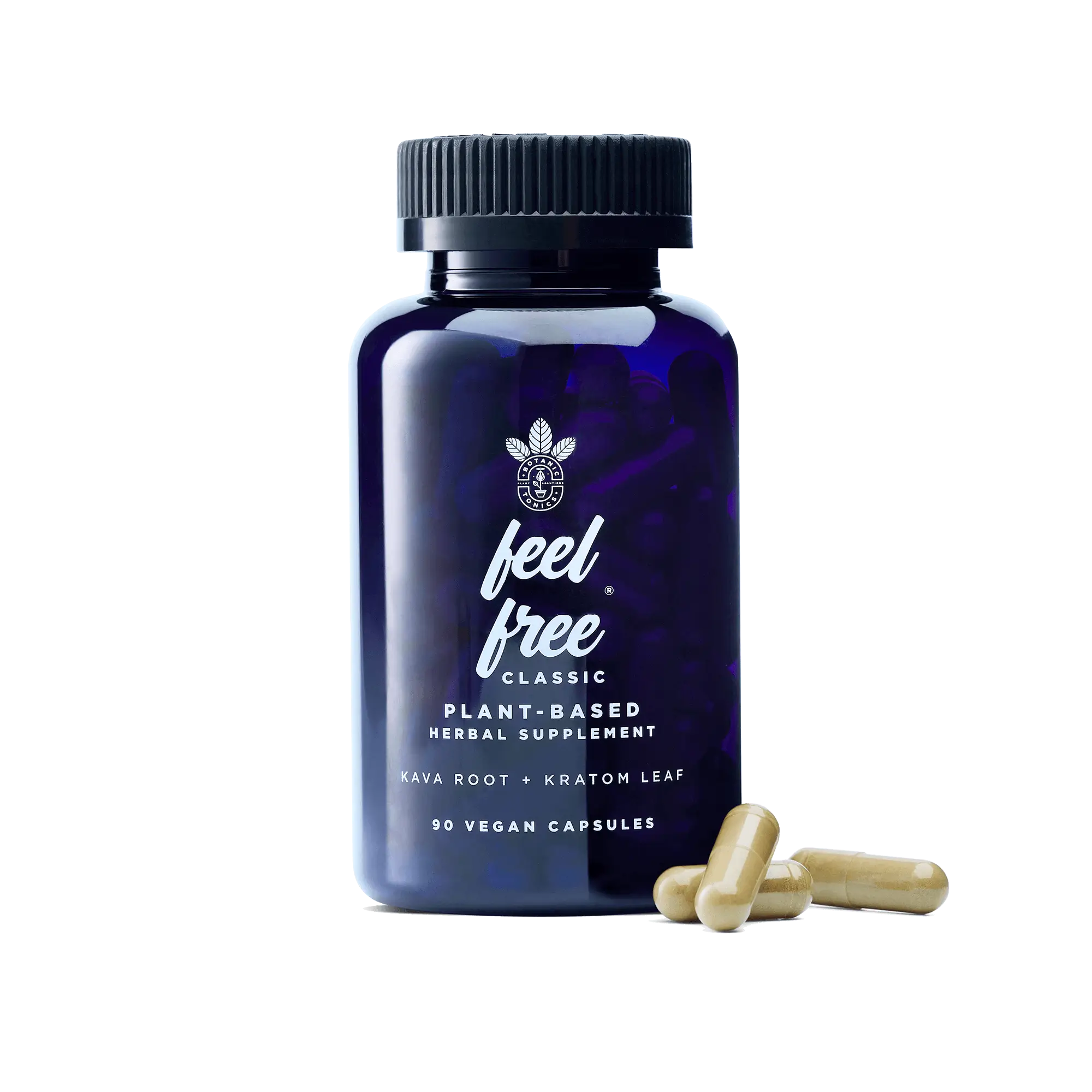Micronized Kava vs Traditional Kava
The South Pacific Islands, an area long-steeped in culture and tradition, is home to the kava plant—a botanical marvel known for its calming, euphoric effects. For centuries, kava, also known as kava kava, has been pivotal in social gatherings and ceremonial rituals, providing a natural conduit for community connection and relaxation.
Have you heard the buzz? If so, you may wonder, is kava right for me?
To answer that you’ll need to do your homework. And, as you do so, you’ll likely stumble across one of the most common debates among kava enthusiasts: micronized kava vs traditional kava.
This guide will break down the differences between instant kava vs micronized kava so you’re properly informed to decide what product is best for you.
Understanding Kava

As mentioned, kava hails from the Pacific Islands. The native cocktail is made from the roots or the stump of Piper methysticum. According to the Drug Foundation:[1]
“Traditionally, Pacific Islanders crushed, chewed and ground the root and stump of the shrub, then soaked it in cold water to produce a recipe for ceremonies and cultural practices. These rituals were said to strengthen ties among groups, reaffirm status and help people communicate with spirits.”
In these cultures, consuming kava is often done expressly for its sedative, hypnotic, and muscle-relaxant effects. It’s believed that kavalactones are the active ingredients within the kava root that interact with the brain and central nervous system to create its anxiolytic and muscle-relaxing properties.[2]
But when it comes to consuming kava extract, you'll notice that there are different kava varieties. There's also the traditional method and the modern way of preparing kava.
What Is Traditional Kava?

Kava kava has been used for ceremonial and recreational purposes since the 18th century.[3] And, to this day, it remains a time-honored practice still observed in many Pacific Island communities.
The term “traditional kava” refers to a drink that’s made using age-old methods. This preparation of traditional kava is part art, part ritual. And, in the Pacific Islands, these elements are as central to the total kava experience.
For instance, kava is the national drink of Fiji. There, it’s typically served in a large communal bowl as a part of a kava ceremony—often used to welcome guests into a village, to mark a special occasion, or to enter a peace agreement. When consumed, it tends to foster a pleasant, numb feeling around the mouth, lips, and tongue, as well as a generalized sense of calm and relaxation.[4]
So, what is kava tea and how is it prepared? Traditional kava is typically prepared in the following way:
- The roots or stump of the kava plant are meticulously scrubbed and cleaned.
- Once free of dirt and debris, the kava is then ground, smashed, or chewed to a pulp.
- The kava pulp is mixed with cold water.
- The mixture is strained to remove fibrous roots and other sediments from the drink.
The final product—a cloudy and earthy drink—may not look as appealing as cocktails like the Boulevardier or Pisco Sour. And, for many newcomers, it will be an acquired taste, with chalky and woody-pine flavors. Because of this, it’s common to have a “kava chaser” like fruit or juice to erase the potentially unpleasant aftertaste.
Even so, it is traditional kava in its purest form. And, if you ever have the opportunity to journey to the Pacific Islands, participating in a kava ceremony is a must-try experience.
Proper Kava Etiquette
If you are fortunate enough to participate in a kava ceremony, there’s proper decorum you should keep in mind. For instance, in Fiji, you should:[5]
- Dress respectfully and modestly for the kava ceremony.
- Bring a kava root as a gift for the host.
- Sit in a circle around the communal kava tanoa (bowl) placed in front of the leader.
- Watch quietly as the kava is pounded and mixed with water.
- When offered kava, clap once and say "Bula!" (Fijian for hello).
- Drink the kava in one gulp, if possible.
- After drinking, clap three more times and end with the word "Maca."
- Sit back and enjoy the experience.
Micronized Kava
Micronized kava is a modern take on the traditional kava drink, blending the ancient benefits of the kava with the conveniences of modern life. It offers a way to enjoy the distinct effects of kava without the elaborate preparation and pageantry, making it a practical choice for those with busy lifestyles or a desire for instant gratification.
As the term "micronized" suggests, this form of kava results from a process that reduces the root to fine particles, much smaller than what is found in traditional preparations. Creating such a delicate powder is only possible with the assistance of modern milling equipment, which ensures consistency in particle size and texture.
A key aspect of micronized kava is the removal of the fibrous parts of the root, known as 'makas,' which are hard to consume and digest. By eliminating these fibers so that only the “golden cream” of the kava root remains, micronized kava offers a smoother, tastier, and more potent experience.
Once the kava root has been processed into this ultra-fine powder, it's ready to be packaged and shipped to kava enthusiasts around the world in one of its various product types, including:
- Brown powder
- Capsules
- Extracts
- Drops
For instance, with micronized powder, preparation is fast and easy. A consumer needs only to mix the micronized kava powder with water or their favorite recipe. Within moments, you have a kava tonic ready to enjoy, with no straining, waiting, or ceremony required. Some may also choose between kava capsules vs. tonic. No matter the personal preference, there’s a variety of kava products available.
Traditional Kava vs Micronized Kava
|
Traditional Kava |
Micronized Kava |
|
|
Preparation |
A lengthy process of mashing, soaking, and straining the kava root |
No preparation is required. Kava powder is mixed directly into water |
|
Taste |
Earthy and bitter flavor that’s an acquired taste |
Similar to traditional kava, though it may be smoother due to the absence of makas |
|
Potency |
Potency varies depending on the quality of the root and the preparation method |
Consistent potency due to modern manufacturing processes |
|
Texture |
Often gritty, especially due to the presence of makas |
Very fine and smooth powder thanks to micronization |
|
Ceremonial value |
High |
Low |
|
Convenience |
Low |
High |
|
Effects |
Promotes relaxation, sociability, and mild euphoria |
Similar effects to traditional kava, though it may have a faster onset of effects |
|
Intoxicating |
No |
No |
Benefits of Micronized Kava
Why has micronized kava grown so popular in the West? Here are a few of its many advantages:
- Convenient – Kava joins the growing trend of ready-to-drink (RTD) and ready-to-mix products, offering a convenient way for busy consumers to incorporate kava into their daily health and wellness routine—all the while ensuring a consistent potency and experience from one drink to the next.
- Promotes relaxation – Between work, family, friends, and home life, modern living is chock-full of stressors and triggers. One of the most well-known effects of kava is its ability to promote a sense of tranquility and peace. Drinking a micronized kava blend as a customary part of your morning routine could help ease the stress that so many people encounter daily.
- Ease aches and discomfort – A lingering injury or muscle discomfort can have a massive impact on your mental health, happiness, and focus, making it hard to work, let alone sleep. But, taking kava as a normal part of your self-care routine could help soothe achy muscles and make it easier to manage physical discomfort.
- Enhances socialization – Feel nervous in social gatherings? Kava could help. Kava has been used traditionally as a social lubricant. In some people, its natural calming effects can help to reduce occasional social anxiety and promote more fluid and comfortable social interactions.
- Improves sleep – Sleep is an essential way a person’s body heals and recovers. It plays an essential role in your overall health, energy levels, and moods. But, given a host of modern stressors, physical discomforts, and distractions, it’s little wonder why many adults have trouble getting the deep sleep their bodies need. Here, taking a sleep-centric kava blend before bed could help you fall and then stay asleep.
See related: Is Kava Addictive?
Micronized Kava from Botanic Tonics

While the traditional kava and its associated preparatory ceremonies have held a sacred place in Pacific Island culture for millennia, its profound benefits are now being embraced around the world in the form of convenient, ready-to-consume micronized kava products.
While both forms share inherent benefits, such as promoting relaxation, easing discomfort, enhancing sociability, and improving sleep, they cater to different preferences.
At feel free, we're proud to bring you plant-based, herbal kava capsules and we’re proud to be on the vanguard of the kava revolution.
Whether you prefer kava capsules or a feel free CLASSIC tonic, we have a range of kava products to explore. We invite you to explore and experience the multitude of kava at feel free.
Sources:
- ADF. Kava. https://adf.org.au/drug-facts/kava/
- Science Direct. Genomic and proteomic mechanisms and models in toxicity and safety evaluation of nutraceuticals. https://www.sciencedirect.com/topics/pharmacology-toxicology-and-pharmaceutical-science/kavalactones
- NIH. Some Drugs and Herbal Products. https://www.ncbi.nlm.nih.gov/books/NBK350450/
- Wine Enthusiast. Get to Know Kava, the Relaxing National Drink of Fiji. https://www.winemag.com/2018/03/21/kava-relaxing-fiji-drink/
- Royal Davui Fiji. What Is Kava? https://royaldavuifiji.com/the-traditional-fijian-kava-ceremony/
















